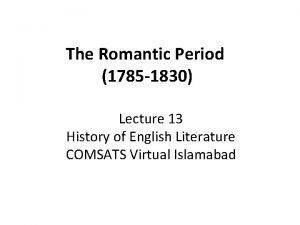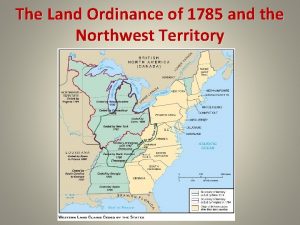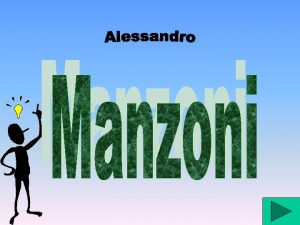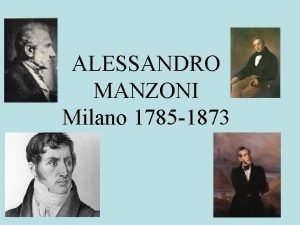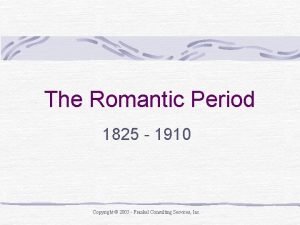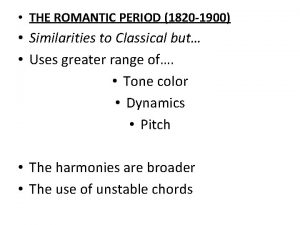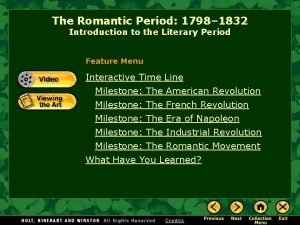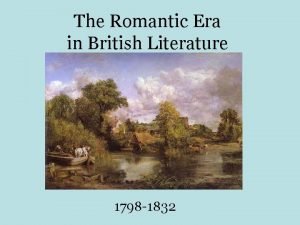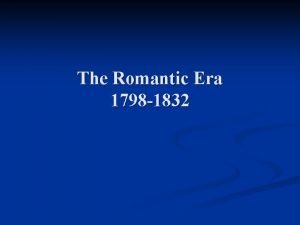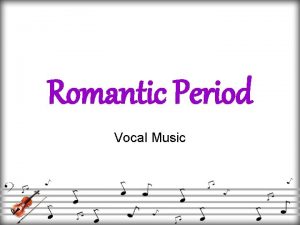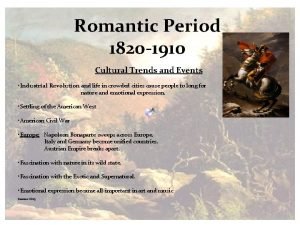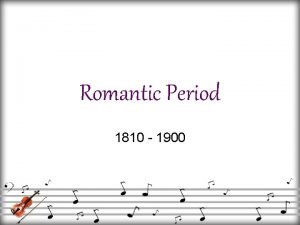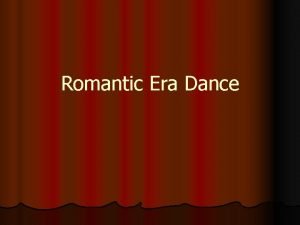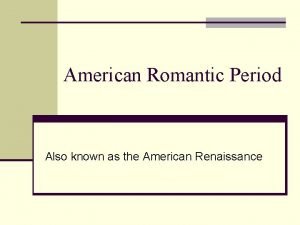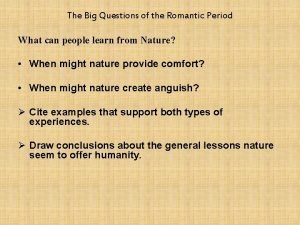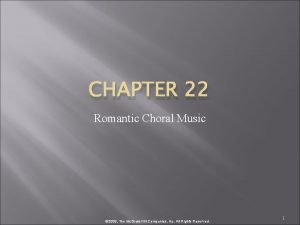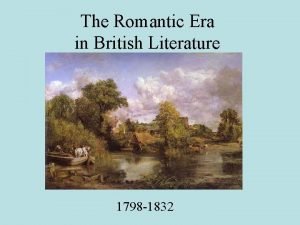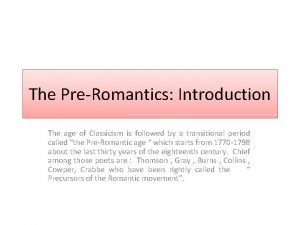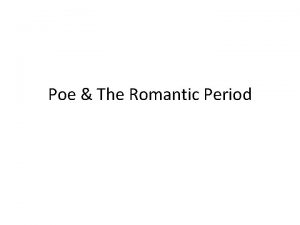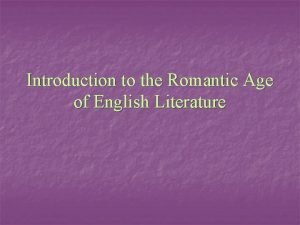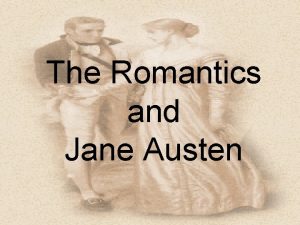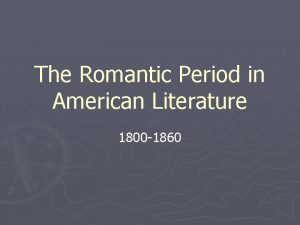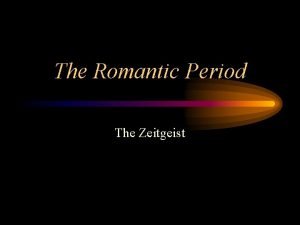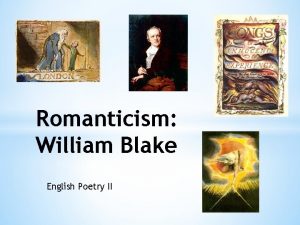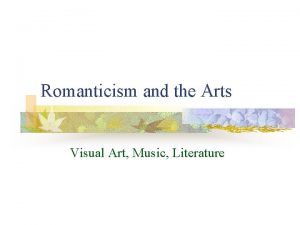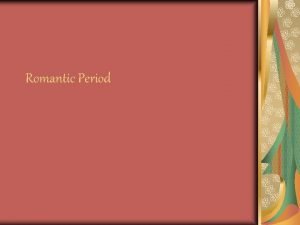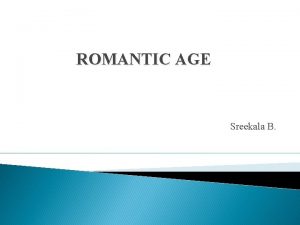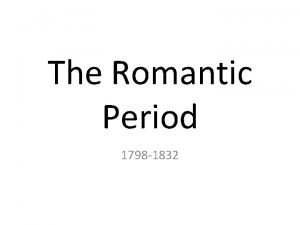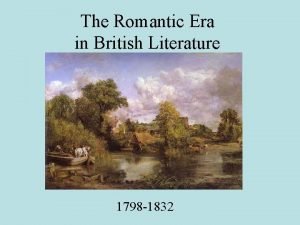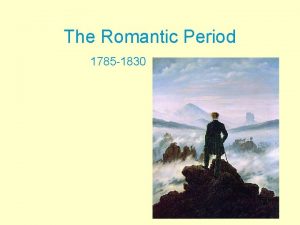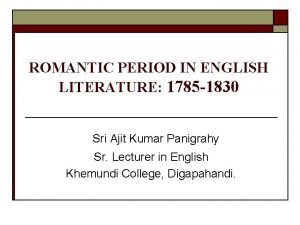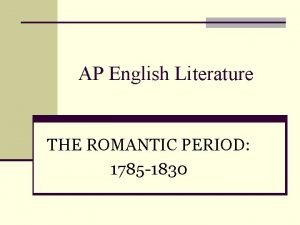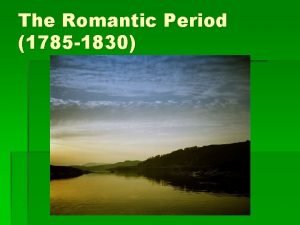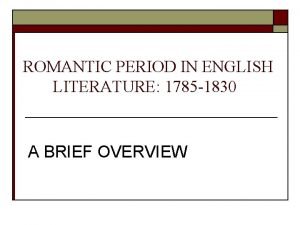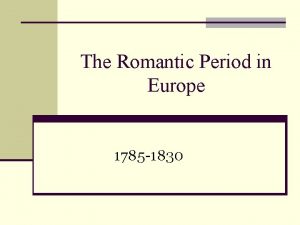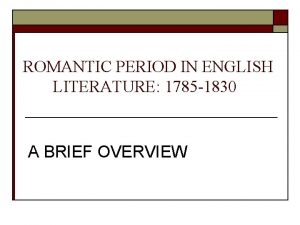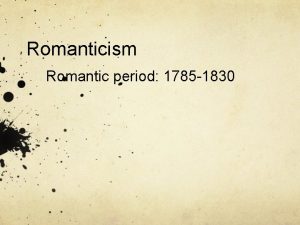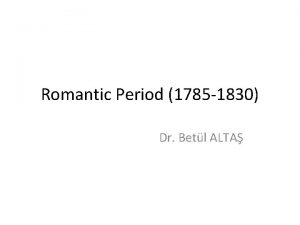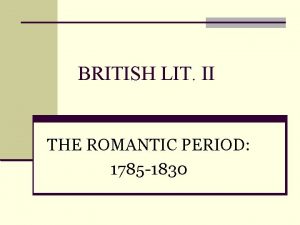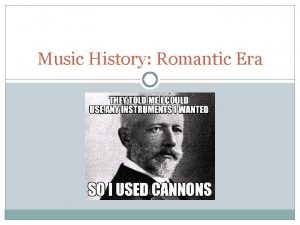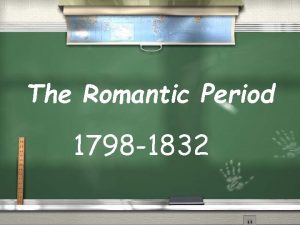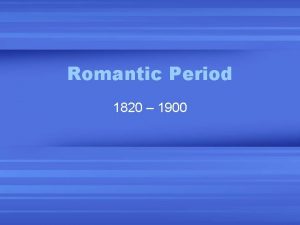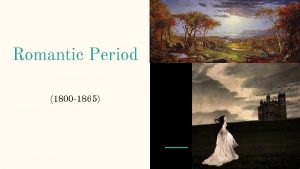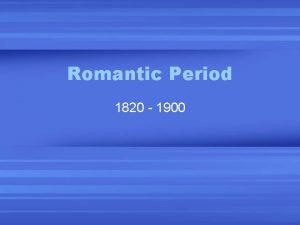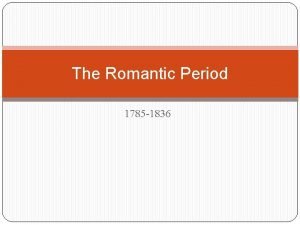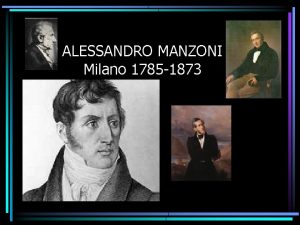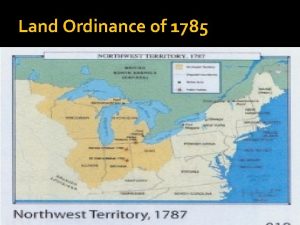The Romantic Period 1785 1830 Lecture 13 History















































- Slides: 47

The Romantic Period (1785 -1830) Lecture 13 History of English Literature COMSATS Virtual Islamabad

Lecture Agenda Romanticism in general • A Movement Across the

Definition v. Romanticism refers to a movement in art, literature, and music during the 19 th century. v. Romanticism is characterized by the 5 “I”s v. Imagination v. Intuition v. Idealism v. Inspiration v. Individuality

Imagination v. Imagination was emphasized over “reason. ” v. This was a backlash against the rationalism characterized by the Neoclassical period or “Age of Reason. ” v. Imagination was considered necessary for creating all art. v. British writer Samuel Taylor Coleridge called it “intellectual intuition. ”

Intuition v. Romantics placed value on “intuition, ” or feeling and instincts, over reason. v. Emotions were important in Romantic art. v. British Romantic William Wordsworth described poetry as “the spontaneous overflow of powerful feelings. ”

Idealism v. Idealism is the concept that we can make the world a better place. v. Idealism refers to any theory that emphasizes the spirit, the mind, or language over matter – thought has a crucial role in making the world the way it is. v. Immanuel Kant, a German philosopher, held that the mind forces the world we perceive to take the shape of space-andtime.

Inspiration v. The Romantic artist, musician, or writer, is an “inspired creator” rather than a “technical master. ” v. What this means is “going with the moment” or being spontaneous, rather than “getting it precise. ”

Individuality v. Romantics celebrated the individual. v. During this time period, Women’s Rights and Abolitionism were taking root as major movements. v. Walt Whitman, a later Romantic writer, would write a poem entitled “Song of Myself”: it begins, “I celebrate myself…”

Origins v. Romanticism began to take root as a movement following the French Revolution. v. The publication of Lyrical Ballads by William Wordsworth and Samuel Taylor Coleridge in 1792 is considered the beginning of literary Romanticism.

The Arts v. Romanticism was a movement across all the arts: visual art, music, and literature. v. All of the arts embraced themes prevalent in the Middle Ages: chivalry, courtly love. Literature and art from this time depicted these themes. Music (ballets and operas) illustrated these themes. v. Shakespeare came back into vogue.

Visual Arts v Neoclassical art was rigid, severe, and unemotional; it hearkened back to ancient Greece and Rome v Romantic art was emotional, deeply-felt, individualistic, and exotic. It has been described as a reaction to Neoclassicism, or “anti-Classicism. ”

Visual Arts: Examples Romantic Art Neoclassical Art

Music v “Classical” musicians included composers like Wolfgang Amadeus Mozart and Franz Josef Haydn. v Romantic musicians included composers like Frederic Chopin, Franz Lizst, Pyotr Il’yich Tchaikovsky

Music: Components v 1730 -1820. v Classical music emphasized internal order and balance. v 1800 -1910. v Romantic music emphasized expression of feelings.

Literature v. In America, Romanticism most strongly impacted literature. v. Writers explored supernatural and gothic themes. v. Writers wrote about nature, love and romance.

• • • Six poets were singled out as the embodiment of the Romantic period (1785 -1830): William Wordsworth, Lord Byron, Samuel Taylor Coleridge, John Keats, Percy Bysshe Shelley William Blake.

As you have probably noticed, the poets are all male poets. You may have heard of them before, but have you heard of these poets who were active in the same period? • Anna Barbauld • Charlotte Smith • Mary Robinson

These three women poets were well known at the time that the other male poets were writing and Wordsworth and Coleridge were almost unknown – they learned their craft or parts of their craft from the three women.

The period was dominated by a number of historical events. • The French Revolution (1785) and the Declaration of the Rights of Man. • Urbanization and enclosure • Industrialization and invention

The French revolution As the French Revolution turned violent, the idea of a peaceful development of society so that property would be equally distributed began to lose its supporters.

The executions in France under Robespierre (the September Massacres of the nobility, the execution of the King and Queen and the Reign of Terror where thousands were guillotined) and the invasion of other countries brought France and England into a war. http: //teachers. ausd. net/antilla/frrevimages. html

• Wordsworth refers to the events in The Prelude (first published 1850) become Oppressors in their turn, Frenchman had changed a war of self-defence For one of Conquest, losing sight of all Which they had struggled for….

Napoleon, the champion of the French revolution had become a despot and the spirit of the revolution was lost. http: //teachers. ausd. net/antilla/frrevimages. html

Urbanisation and Enclosure • The largely agricultural society of England changed to a manufacturing society and power-driven machinery replaced labour by hand. http: //freepages. genealogy. rootsweb. ancestry. com/~todmordenandwalsden/homeweaving. htm

• The movement from agriculture to manufacturing meant that urbanization took place and the mill towns’ populations exploded. Typical cottage: http: //freepages. genealogy. rootsweb. ancestry. com /~todmordenandwalsden/homeweaving. htm Mill town: http: //www. flickr. com/photos/blvesboy/2121487586/

• This movement of people from agricultural areas to towns was aided by a process of enclosure. The checkerboard of fields enclosed by hedges or stone walls that are evident in many parts of England are the result of this.

More efficient methods of agriculture meant that communally worked farms were converted to privately owned farms and a landless class emerged who moved into the towns. http: //www. mtholyoke. edu/courses/rschwart/ind_rev/images/indust. html. htm

Industrial revolution and invention • Steam power replaced wind power and the power to run the manufacturing industries was produced by water. Steam train: Watt’s Steam Engine: http: //www. mtholyoke. edu/courses/rschwart/ind_rev/images/indust. html 14. htm http: //www. historywiz. com/indrevimage. htm

The economic philosophy of laissez-faire, or the “let alone” theory in economics meant that the economy would be left to run itself and the government should not interfere.

The consequences of this economic philosophy were many: • Inadequate wages • Long hours of work, harsh discipline and bad working conditions • The large-scale unemployment of women and children (the family worked together as a unit before).

• Gendered working roles came into play at this time – and poor houses put children to work. http: //www. spartacus. schoolnet. co. uk/IRworkhouse. children. htm

• Petitions, protest meetings, hunger riots. (the workers had no vote and it was illegal to form unions). http: //www. mtholyoke. edu/courses/rschwart/ind_rev/images/indust. html. htm • Oppressive measures by the ruling class.

• The introduction of new machinery led to more unemployment and attempts to destroy the machinery. A Spinning Jenny:

http: //www. francesfarmersrevenge. com/stuff/archive/oldnews 3/luddite. htm • The House of Lords passed a bill (1812) that sentenced anyone who destroyed weaving machinery to a death penalty.

http: //www. schoolshistory. org. uk/Industrial. Revolution/images/Street 1 a. jpg As the poor suffered, the landed classes and industrialists prospered and the British Empire expanded.

Influences of the romantic poets • The distress of the working class and everyday life • The move from agriculture and nature to the overfilled towns and industrialization. • The “romantic” idea of the French Revolution These influences led to what was called ”The Spirit of the Age”

The Spirit of the age • A sense that there was a new intellectual climate. • A release of energy that was captured by experimentation and creative power and accompanied by a spirit of political and social revolution. • The French Revolution had given rise to a time of promise and revolution; this was expressed in the poetry of the time. • Traditions and customs were discarded and new ideas and renewal were the future.

• Before the Romantic period, poetry was considered to be an imitation of life or a “mirror held up to nature. ” But… • Wordsworth, for example, saw poetry as “the spontaneous overflow of powerful feelings, ” thus reversing the previous ideas.

Wordsworth located the source of a poem inside the individual instead of the outer world – in the inner feelings, emotion or the imaginative vision of the author.

• There is an insistence on the role of instinct, intuition and the feelings of the heart over the logical thoughts located in the head. • This change is a deliberate revolt against the 18 th century scientific worldview and the dominant poetic tradition of the time.

The main subject of the Romantic poets: • Everyday life and the usage of plain language. • The humble person, the outcast, convicts, female and male vagrants, idiot boys, peasants, village barbers, peddlers and mothers (similar subjects were on the periphery of poetry before). • The focus on imagination

• Only Lord Byron among the romantics stayed loyal to the poets’ decorum and the aristocratic ways of old: ’Peddlars, ’ and ‘Boats, ’ and ‘Wagons’! Oh! Ye shades Of Pope and Drydon, are we come to this? Alexander Pope (1688 -1744) and John Dryden (1631 -1700) belonged to the older poetic tradition.

Lord Byron and David Durie When you have read Disgrace you will be aware that there are many references to Lord Byron (1788 -1824) , in fact Durie is in the process of writing an opera about Byron. What is the influence of Lord Byron on English literature and even further afield?

Aspects of Lord Byron's poetry influenced not only writers like Goethe, Balzac, Stendahl, Pushkin, Dostoevsky and Melville, but also painters and composers (for example, Beethoven). Lord Byron and his influence also extends to Emily and Charlotte Brontê.

Emily Bronte's character Heathcliff in Wuthering Heights and Charlotte Bronte's Rochester in Jane Eyre have been described as "Byronic heroes. " What characteristics does a Byronic hero have?

In The Norton Anthology of English Literature Vol. 2 (7 th Edition) the Byronic hero is described: [H]e is an alien, mysterious, and gloomy spirit, superior in his passions and powers to the common run of humanity, whom he regards with disdain. He harbors the torturing memory of an enormous, nameless guilt that drives him toward an inevitable doom. He is in his isolation absolutely self-reliant, pursuing his own ends according to his self-generated moral code against any opposition, human or supernatural. And he exerts an attraction on other characters that is the more compelling because it involves their terror at his obliviousness to ordinary human concerns and values. This figure, infusing the archrebel in a nonpolitical form with a strong erotic interest; was imitated in life as well as in art and helped shape the intellectual and the cultural history of the later nineteenth century (552).

REFERENCE The Norton Anthology of English Literature (7 th ed. , vol. 2), “The Romantic Period 17851830” (1 -14)
 5 i's of romanticism
5 i's of romanticism What period lasted from 1750-1825?
What period lasted from 1750-1825? Land ordinance of 1785
Land ordinance of 1785 Nato a milano nel 1785
Nato a milano nel 1785 Scrittore nato a milano 1785
Scrittore nato a milano 1785 1785 periodo storico
1785 periodo storico Milano 1785
Milano 1785 Siya ang hari ng espanya sa panahon ni jose basco
Siya ang hari ng espanya sa panahon ni jose basco 01:640:244 lecture notes - lecture 15: plat, idah, farad
01:640:244 lecture notes - lecture 15: plat, idah, farad Wagner romantic
Wagner romantic Romantic era american literature
Romantic era american literature Characteristics of the romantic period
Characteristics of the romantic period Characteristics of romantic period
Characteristics of romantic period The romantic period 1798 to 1832 summary
The romantic period 1798 to 1832 summary The romantic period 1798 to 1832
The romantic period 1798 to 1832 Romantic period
Romantic period The romantic period 1798 to 1832 summary
The romantic period 1798 to 1832 summary Characteristic of romantic art
Characteristic of romantic art Vocal music of the romantic period
Vocal music of the romantic period Principles of romanticism
Principles of romanticism Romantic period poetry characteristics
Romantic period poetry characteristics Music of the romantic period
Music of the romantic period Characteristic of the romantic period
Characteristic of the romantic period The nutcracker
The nutcracker What served as the seed of activism?
What served as the seed of activism? American romantic period
American romantic period Questions about romanticism literature
Questions about romanticism literature Romantic period choral music
Romantic period choral music Romantic period in british literature
Romantic period in british literature Romanticism poetry characteristics
Romanticism poetry characteristics Thomas gray as a pre romantic poet
Thomas gray as a pre romantic poet Romantic time period
Romantic time period Romanticism dates
Romanticism dates Romantic literature definition
Romantic literature definition Jane austen romanticism
Jane austen romanticism American romantic period
American romantic period Elements of romantic
Elements of romantic Characteristics of the romantic period
Characteristics of the romantic period Romantic age starts from
Romantic age starts from Characteristic of romanticism
Characteristic of romanticism Describe neoclassical and romantic period
Describe neoclassical and romantic period Characteristic of romantic period
Characteristic of romantic period Characteristic of romantic period
Characteristic of romantic period Romantic theater plays
Romantic theater plays Queen mab characteristics
Queen mab characteristics Cavalier and metaphysical poetry
Cavalier and metaphysical poetry Romantic period 1798 to 1832
Romantic period 1798 to 1832 1798 in english literature
1798 in english literature
